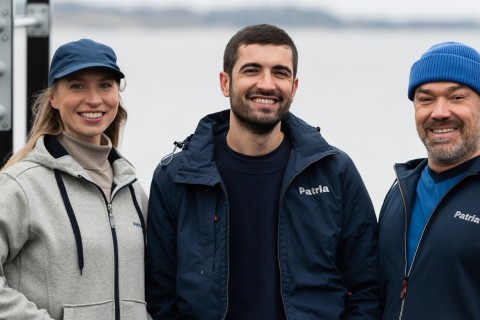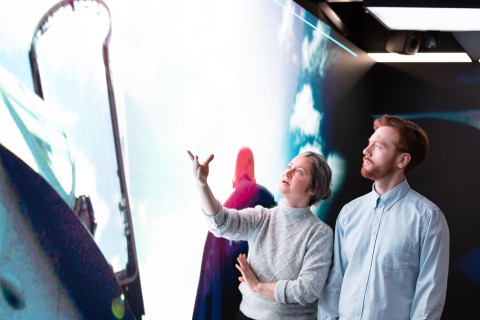
5.12.2016
Growth in air travel requires the training of hundreds of thousands of new civilian pilots. Patria Pilot Training is strengthening its position in the growing training market.
Text: Matti Remes
Photos: Matti Immonen
While the aviation sector has suffered from the turbulence caused by economic crises and terrorism during the past few years, prospects for long-term growth have remained stable.
The International Air Transport Association (IATA) has forecast that the number of air passengers will double by 2034 from the current number, which is estimated to be 3.5 billion annually.
The aircraft manufacturer Airbus estimates that 33,000 new airliners and half a million new pilots will be needed in the world during the next 20 years.
"Forecasts are just forecasts. However, it is certain that the world needs to train significantly more pilots during the next few decades," comments Mikko Paronen, Managing Director of Patria Pilot Training.
China exhibits the most notable growth figures
Mikko Paronen, Managing Director of Patria Pilot Training.
Just a few years ago, there was an oversupply of pilots in the world. Today, a shortage of pilots is gradually emerging in many countries.
"In addition to a growing demand for air travel, pilots will be needed to replace those who retire" Paronen says.
In aviation, the emerging economies in Asia exhibit the most rapid growth. The annual number of passengers in China is expected to increase from the current 0.5 billion to 1.19 billion by 2034.
The countries exhibiting the most vigorous growth also include India and Indonesia. In the rich oil countries of the Gulf, growth is also strong.
"In the United States, the aviation sector also shows clear growth. Air traffic is also expected to grow in many African countries.In addition to scheduled traffic, charter and freight services require new pilots. New helicopter pilots are also in growing demand."
A demanding international profession
Mikko Paronen says that in order for the industry to be able to meet its need for pilots, a sufficient number of interested young people must embark on a career in aviation.
The two-year basic training of a commercial pilot comprises extensive theoretical studies of around one thousand hours and, depending on the training programme, approximately 200 to 250 flight hours.
"In order to become a pilot, the applicant must pass aptitude tests and a medical examination. Normal physical condition is sufficient. The pilot may wear spectacles but must not have any chronic illnesses," Paronen says.
A pilot’s profession is international, which provides pilots with opportunities to work practically anywhere in the world. After gradually gaining flight experience, a co-pilot may be promoted to captain.
Paronen says that captains in particular are now in short supply.
"The work experience required for the rank of captain varies from one country or airline to another. While at some companies, three to four years as a co-pilot will suffice, at others, as much as ten years may be required."
New type of training
Patria Pilot Training, part of the Patria Group, offers training for both individual pilots and airlines. The company will transfer its operations to completely new facilities at Tampere-Pirkkala Airport after the traffic control services at Helsinki-Malmi Airport are discontinued at the turn of the year 2016/2017.
Paronen says that Patria’s pilot training will be increasingly targeted at collaboration with airlines.
"We are strongly involved in the training of pilots for Finnish airlines. After a number of slow years, Finnish airlines are again recruiting pilots."
New customers from abroad
Patria has trained international customers from countries such as Russia and Kazakhstan.
"We will increasingly target the international market," Paronen says.
The largest international training market is the United States, which has a great number of both small and large aviation schools. Europe also has plenty of players.
"Our goal is to become the leading training organisation in Northern Europe."
Patria Pilot Training is seeking new international customers, for example, at aviation fairs. According to Paronen, the key issue is to establish direct contacts with airlines and to engage in networking.
"All airlines that have placed major orders for aircraft are potential customers. Establishing direct contacts will require time. However, after you get to know people and tell them about high-quality Finnish pilot training, you begin to secure deals."
The state as an owner develops trust
According to Paronen, Finland’s strong brand in education also gives Patria a competitive edge in the fiercely competitive pilot training market. Another asset is the ownership base of Patria Pilot Training.
"Patria’s ownership, in which the state is the major shareholder, contributes positively to our credibility. Customers regard us as an operator with sufficient resources to provide high-quality training and act in a responsible manner."
Perhaps somewhat surprisingly, the varied Finnish weather conditions are an advantage for pilot training.
Already during their training, pilots will experience various conditions, ranging from hot sunshine to blizzards.
"In their future work, the key issue for pilots is to be able to operate under highly varied conditions and to anticipate changing weather conditions. It is good if the pilots gain familiarity with such conditions while they are still in training."
Finland is a good country for trainees
Paronen says that the training that Patria provides in English has earned positive feedback from students. One aspect of the training that trainees have praised is its clarity.
"Students comment that it is often easier to understand Finnish trainers than British or American instructors who speak English as their native language."
Paronen says that those who are searching for an aviation school also consider aspects other than the quality of training.
"Students and their families appreciate safe and stable conditions. While Finland is a relatively expensive country for students, everything works here."
A key element of Patria’s service offering
Jukka Holkeri, Chief Strategy Officer at Patria, says that pilot training is a key element of Patria’s life-cycle support services, which also include maintenance, overhauls, upgrades, modifications and repairs of various platforms.
"Civilian pilot training is a growth industry, for which Patria Pilot Training can offer competitive services," Holkeri says.
Within the Patria Group, the Aviation Business Unit is in charge of offering basic training to the Finnish Air Force, the Finnish Army, and the Border Guard. Holkeri says that the fact that the same group offers civilian and military pilot training means that there are several synergies regarding the training equipment and the maintenance of aircraft, for example.
The fact that Patria’s Aerostructures business unit manufactures structures for commercial aircraft, and is actively involved in the development of new composite technologies and applications, also provides synergies through market presence and understanding.
What did you like about the article?
Thank you for your opinion! You can share the article on social media using the buttons below:




























